Enhanced Electroplasticity through Room-Temperature Dynamic Recrystallization in a Mg-3Al-1Sn-1Zn Alloy
Abstract
:1. Introduction
2. Experimental Procedures
3. Results and Discussion
3.1. Mechanical Behavior during Tensile Test under Pulse Current
3.2. Microstructure Evolution and Dynamic Recrystallization Behavior during Pulse Current Tensile Test
3.3. Texture Evolution during Pulse Current Tensile Test
4. Conclusions
Author Contributions
Funding
Conflicts of Interest
Abbreviations
| Abbreviation | Meaning |
| ATZ311 | Mg-3Al-1Sn-1Zn |
| EDSD | electron backscattered diffraction |
| DRX | dynamical recrystallization mechanisms |
| CDRX | continue dynamical recrystallization mechanisms |
| ED | extruded direction |
| TD | transverse direction |
| ND | normal direction |
| JP | peak current densities |
| LAGB | low angle grain boundary |
| HAGB | high angle grain boundary |
References
- Hono, K.; Mendis, C.L.; Sasaki, T.T.; Oh-ishi, K. Towards the development of heat-treatable high-strength wrought Mg alloys. Scripta Mater. 2010, 63, 710–715. [Google Scholar] [CrossRef]
- Zhang, D.D.; Yang, Q.; Guan, K.; Li, B.S.; Wang, N.; Qin, P.F.; Jiang, B.; Sun, C.; Qin, X.; Tian, Z.; et al. A high-strength low-rare-earth-alloyed magnesium alloy via traditional hot-extrusion. J. Alloys Compd. 2019, 810, 151967. [Google Scholar] [CrossRef]
- Wang, Y.; Choo, H. Influence of texture on Hall-Petch relationships in an Mg alloy. Acta Mater. 2014, 81, 83–97. [Google Scholar] [CrossRef] [Green Version]
- Li, C.; Zhang, K.F.; Jiang, S.S.; Zhao, J.P. Pulse current auxiliary bulging and deformation mechanism of AZ31 magnesium alloy. Mater. Des. 2010, 34, 170–178. [Google Scholar] [CrossRef]
- Xu, Z.H.; Tang, G.Y.; Tian, S.Q.; Ding, F.; Tian, H.Y. Research of electroplastic rolling of AZ31 Mg alloy strip. J. Mater. Process. Technol. 2007, 182, 128–133. [Google Scholar] [CrossRef]
- Xiang, S.Q.; Zhang, X.F. Dislocation structure evolution under electroplastic effect. Mater. Sci. Eng. A 2019, 761, 138026. [Google Scholar] [CrossRef]
- Li, W.; Shen, Y.; Liu, H.T.; Wang, Y.; Zhu, W.J.; Xie, C.Y. Non-octahedral-like dislocation glides in aluminum induced by athermal efect of electric pulse. J. Mater. Res. 2016, 31, 1193–1200. [Google Scholar] [CrossRef]
- Sheng, Y.Y.; Hua, Y.L.; Wang, X.J.; Zhao, X.Y.; Chen, L.X.; Zhou, H.Y.; Wang, J.; Berndt, C.; Wei, L. Application of high-density electropulsing to improve the performance of metallic materials: Mechanisms, microstructure and properties. Materials 2018, 11, 185. [Google Scholar] [CrossRef] [Green Version]
- Islam, Z.; Wang, B.M.; Haque, A. Current density effects on the microstructure of zirconium thin films. Scripta Mater. 2018, 144, 18–21. [Google Scholar] [CrossRef]
- Zhao, S.T.; Zhang, R.P.; Chong, Y.; Li, X.Q.; Abu-Odeh, A.; Rothchild, E.; Chrzan, D.C.; Asta, M.; Morris, J.W.M.; Minor, A.M. Defect reconfiguration in a Ti—Al alloy via electroplasticity. Nat. Mater. 2021, 20, 468–472. [Google Scholar] [CrossRef]
- Kim, M.J.; Yoon, S.; Park, S.; Jeong, H.J.; Park, J.W.; Kim, K.; Jo, J.; Heo, T.; Hong, S.T.; Cho, S.H.; et al. Elucidating the origin of electroplasticity in metallic materials. Applied Mater. Today 2010, 21, 100874. [Google Scholar]
- Xiao, S.H.; Guo, J.D.; Wu, S.D.; He, G.H.; Li, S.X. Recrystallization in fatigued copper single crystals under electropulsing. Scripta Mater. 2002, 46, 1–6. [Google Scholar] [CrossRef]
- Jiang, Y.B.; Tang, G.Y.; Shek, C.H.; Liu, W. Microstructure and texture evolution of the cold-rolled AZ91 magnesium alloy strip under electropulsing treatment. J. Alloys Compd. 2011, 509, 4308–4313. [Google Scholar] [CrossRef]
- Guan, L.; Tang, G.Y.; Jiang, Y.B.; Chu, P.K. Texture evolution in cold-rolled AZ31 magnesium alloy during electropulsing treatment. J. Alloys Compd. 2009, 487, 309–313. [Google Scholar] [CrossRef]
- Conrad, H.; Karam, N.; Mannan, S. Effect of prior cold work on the influence of electric current pulses on the recrystallization of copper. Scripta Mater. 1984, 18, 275–280. [Google Scholar] [CrossRef]
- Park, J.-W.; Jeong, H.-J.; Jin, S.-W.; Kim, M.-J.; Lee, K.; Kim, J.J.; Hong, S.-T.; Han, H.N. Effect of electric current on recrystallization kinetics in interstitial free steel and AZ31 magnesium alloy. Mater. Charact. 2017, 133, 70–76. [Google Scholar] [CrossRef]
- Sarker, D.; Chen, D.L. Detwinning and strain hardening of an extruded magnesium alloy during compression. Scripta Mater. 2010, 67, 165–168. [Google Scholar] [CrossRef]
- Khosravani, A.; Fullwood, D.T.; Adams, B.L.; Rampton, T.M.; Miles, M.P.; Mishra, R.K. Nucleation and propagation of {10–12} twins in AZ31 magnesium alloy. Acta Mater. 2015, 100, 202–214. [Google Scholar] [CrossRef] [Green Version]
- Koike, J. Enhanced deformation mechanisms by anisotropic plasticity in polycrystalline Mg alloys at room temperature. Metal. Mater. Trans. A 2005, 36A, 1689–1696. [Google Scholar] [CrossRef]
- Salem, A.A.; Kalidindi, S.R.; Doherty, R.D. Strain hardening of titanium: Role of deformation twinning. Acta Mater. 2003, 51, 4225–4237. [Google Scholar] [CrossRef]
- Mackenzie, L.W.F.; Pekguleryuz, M.O. The recrystallization and texture of magnesium–zinc–cerium alloys. Scripta Mater. 2008, 59, 665–668. [Google Scholar] [CrossRef]
- Wang, M.Y.; Xin, R.L.; Wang, B.S.; Liu, Q. Effect of initial texture on dynamic recrystallization of AZ31 Mg alloy during hot rolling. Mater. Sci. Eng. A 2001, 528, 2941–2951. [Google Scholar] [CrossRef]
- Chao, H.Y.; Sun, H.F.; Chen, W.Z.; Wang, E.D. Static recrystallization kinetics of a heavily cold drawn AZ31 magnesium alloy under annealing treatment. Mater. Charact. 2001, 62, 312–320. [Google Scholar] [CrossRef]
- Couret, A.; Caillard, D. An in situ study of prismatic glide in magnesium—II. Microscopic activation parameters. Acta Metall. 1985, 33, 1447–1454. [Google Scholar] [CrossRef]
- Püschl, W.; Schoeck, G.; Kirchner, H.O.K. The line tension of dislocations in anisotropic media. Philos. Mag. 1987, 56, 553–563. [Google Scholar] [CrossRef]
- Koike, J.; Kobayashi, T.; Mukai, T.; Watanabe, H.; Suzuki, M.; Maruyama, K.; Higashi, K. The activity of non-basal slip systems and dynamic recovery at room temperature in fine-grained AZ31B magnesium alloys. Acta Mater. 2003, 51, 2055–2065. [Google Scholar] [CrossRef]
- Yi, S.B.; Brokmeier, H.G.; Bolmaro, R.E.; Kainer, K.U.; Lippmann, T. In situ measurements of texture variations during a tensile loading of Mg-alloy AM20 using synchrotron X-ray radiation. Scripta Mater. 2004, 51, 455–460. [Google Scholar] [CrossRef]
- Yi, S.B.; Davies, C.H.J.; Brokmeier, H.G.; Bolmaro, R.E.; Kainer, K.U.; Homeyer, J. Deformation and texture evolution in AZ31 magnesium alloy during uniaxial loading. Acta Mater. 2006, 54, 549–562. [Google Scholar] [CrossRef]
- Xu, S.W.; Oh-ishi, K.; Kamado, S.; Homma, T. Twins, recrystallization and texture evolution of a Mg–5.99 Zn–1.76 Ca–0.35 Mn (wt.%) alloy during indirect extrusion process. Scripta Mater. 2011, 65, 875–878. [Google Scholar] [CrossRef]
- Oh-ishi, K.; Mendis, C.L.; Homma, T.; Kamado, S.; Ohkubo, T.; Hono, K. Bimodally grained microstructure development during hot extrusion of Mg–2.4 Zn–0.1 Ag–0.1 Ca–0.16 Zr (at.%) alloys. Acta Mater. 2009, 57, 5593–5604. [Google Scholar] [CrossRef]
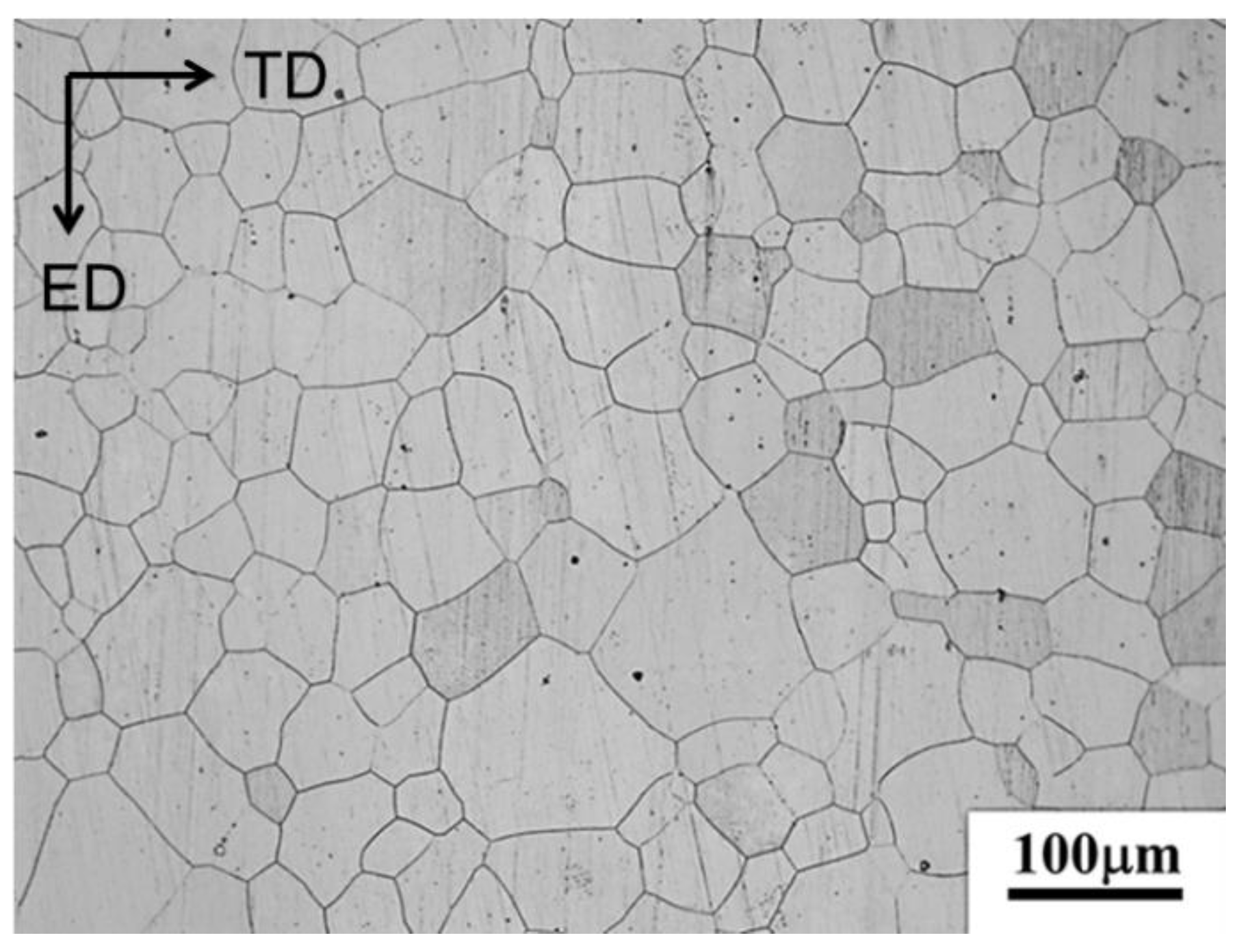
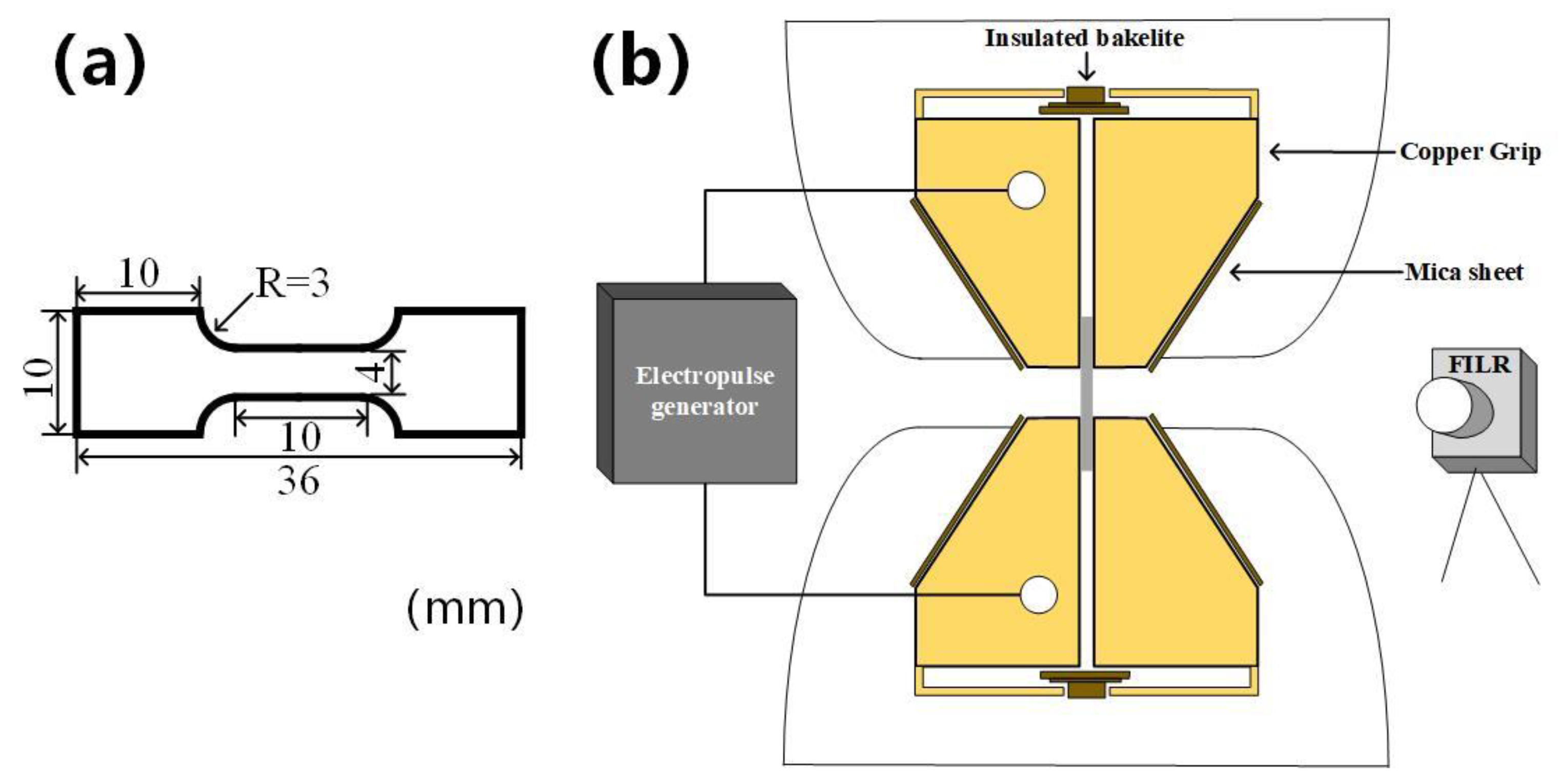
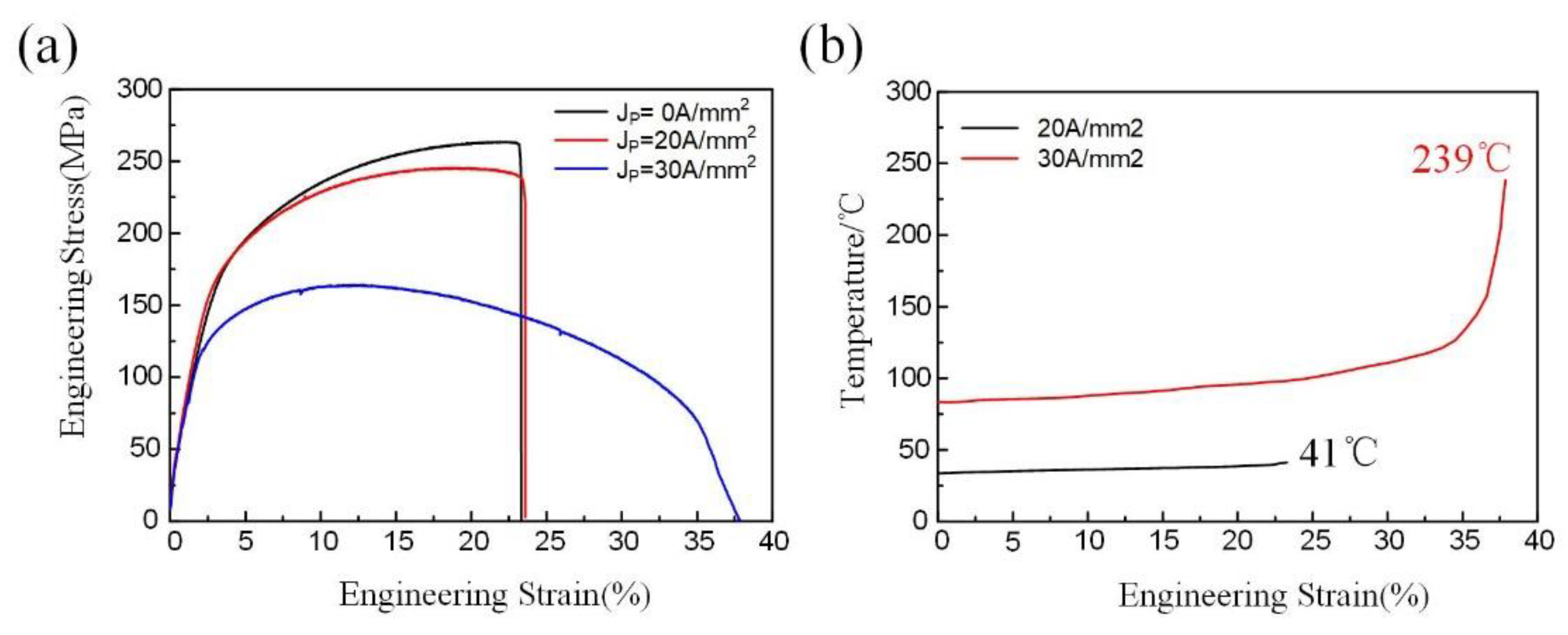
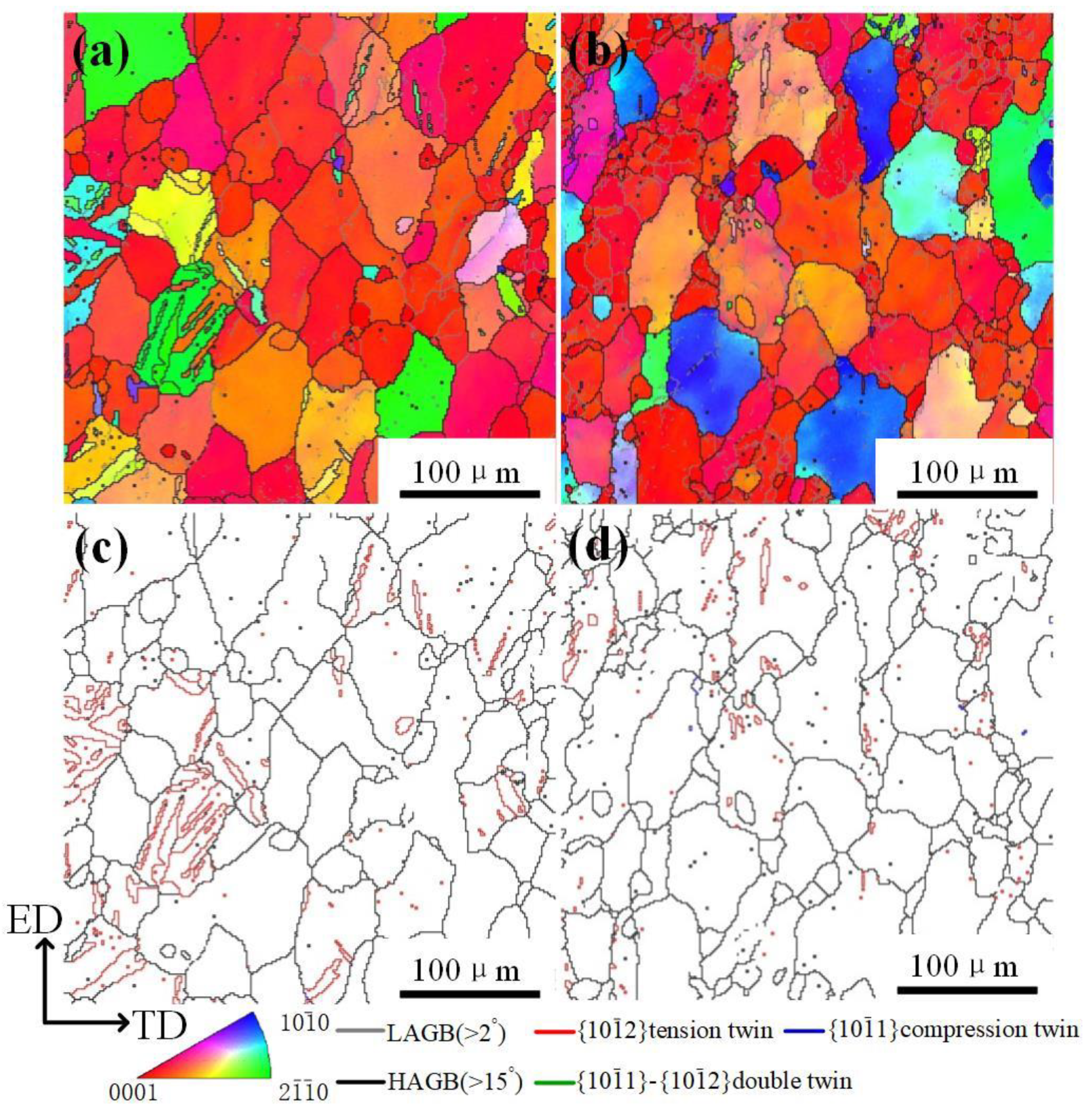
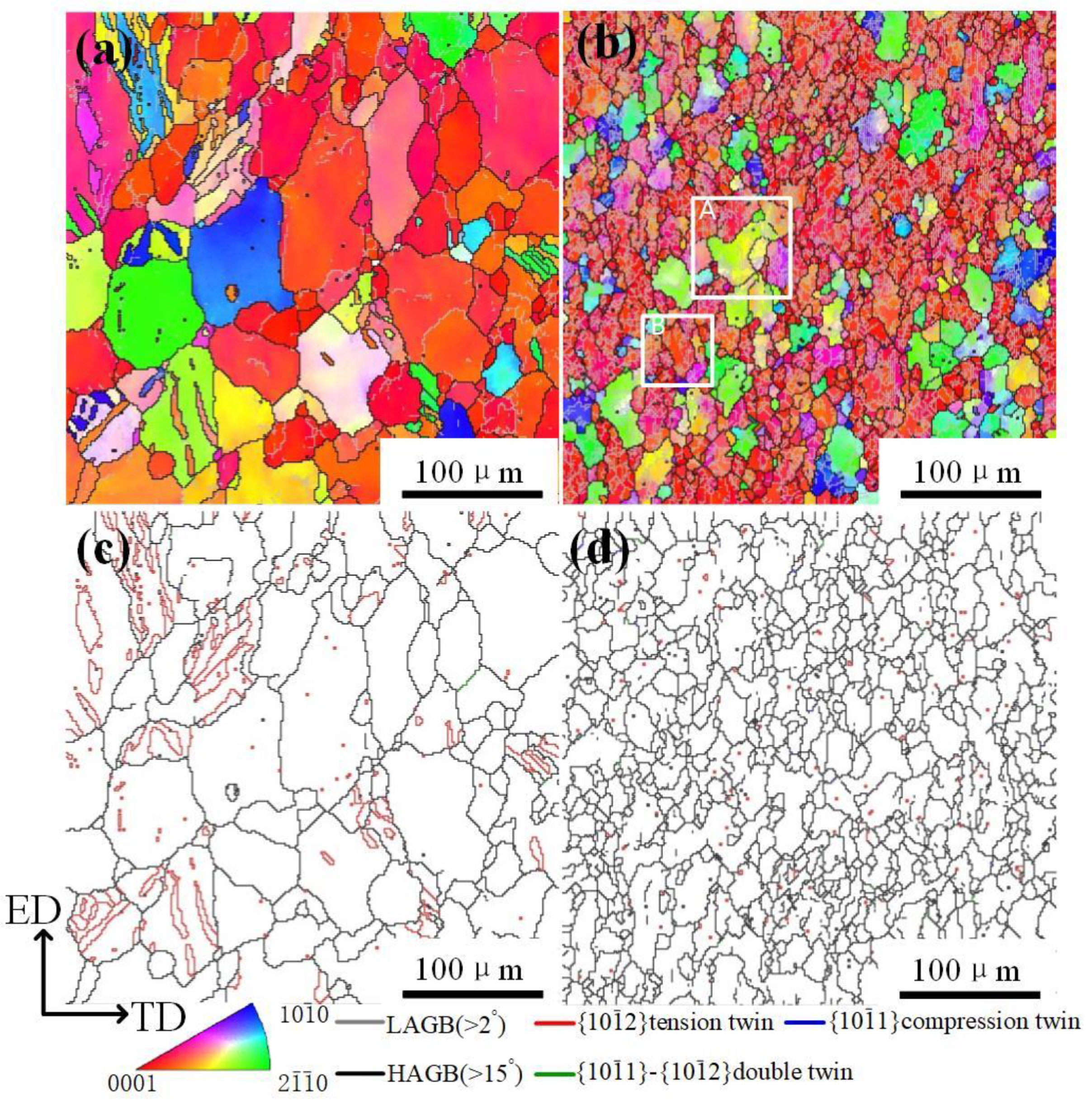
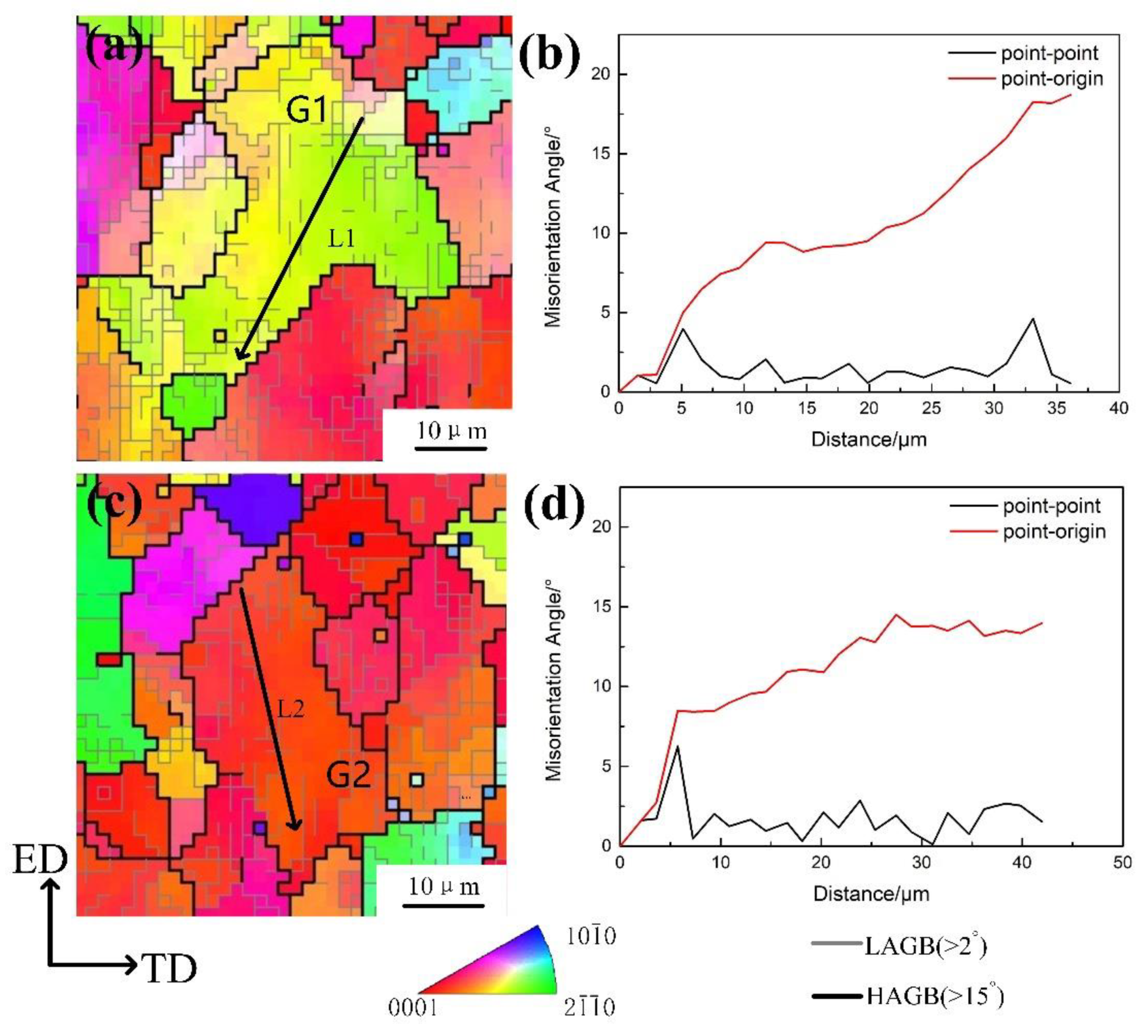

| Voltage | Periodicity | Duration | JP | |
|---|---|---|---|---|
| 1 | 12 V | 2000 μs | 500 μs | 20 A/mm2 |
| 2 | 12 V | 2000 μs | 500 μs | 30 A/mm2 |
Publisher’s Note: MDPI stays neutral with regard to jurisdictional claims in published maps and institutional affiliations. |
© 2021 by the authors. Licensee MDPI, Basel, Switzerland. This article is an open access article distributed under the terms and conditions of the Creative Commons Attribution (CC BY) license (https://creativecommons.org/licenses/by/4.0/).
Share and Cite
Xu, H.; Zou, Y.-J.; Huang, Y.; Ma, P.-K.; Guo, Z.-P.; Zhou, Y.; Wang, Y.-P. Enhanced Electroplasticity through Room-Temperature Dynamic Recrystallization in a Mg-3Al-1Sn-1Zn Alloy. Materials 2021, 14, 3739. https://doi.org/10.3390/ma14133739
Xu H, Zou Y-J, Huang Y, Ma P-K, Guo Z-P, Zhou Y, Wang Y-P. Enhanced Electroplasticity through Room-Temperature Dynamic Recrystallization in a Mg-3Al-1Sn-1Zn Alloy. Materials. 2021; 14(13):3739. https://doi.org/10.3390/ma14133739
Chicago/Turabian StyleXu, Hong, Yu-Jie Zou, Yu Huang, Pin-Kui Ma, Zhi-Peng Guo, You Zhou, and Yu-Peng Wang. 2021. "Enhanced Electroplasticity through Room-Temperature Dynamic Recrystallization in a Mg-3Al-1Sn-1Zn Alloy" Materials 14, no. 13: 3739. https://doi.org/10.3390/ma14133739





